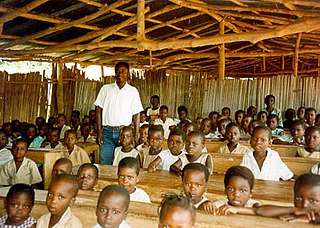Current status
School system

The Belizean school system is a loose aggregate of education subsystems. The system is based on British education and is broken into three levels: Primary education, Secondary education and Tertiary education. Belizean children begin their eight years of primary education with two years of "infant" classes, followed by six "standards." Secondary education is divided into four "forms." Sixth form is a two-year post-secondary course, originally intended to prepare students for the Cambridge Advanced or "A-Level" examinations. Since the early 1970s, sixth-form institutions have also bestowed Associate of Arts degrees sanctioned by the United States Association of Junior Colleges. [5]
Other post-secondary institutions include the University of Belize, Galen University, Wesley Junior College, in addition to UCB. Belize contributes to and participates in the multinational University of the West Indies. The University of the West Indies maintains an Open Campus site in Belize City. [6]
Management of the system varies according to level. In the latter half of the 1980s, religious denominations controlled the majority of primary schools. The government or private, community-based boards of governors administered more than 50 percent of the secondary institutions. The preponderance of government institutions at the secondary level is a relatively new development; as recently as 1980, the majority of secondary schools were under religious management. Still, denominational representatives retain considerable influence on the managing boards of private, ostensibly nondenominational, institutions. [5]
Secondary schools differ according to curriculum and cultural orientation. Most private and denominational schools emphasize academic and commercial studies, although some also offer technical-vocational programs. In contrast, the government directly manages nine schools, all of which offer a curriculum oriented to technical-vocational subjects. [5]
In cultural orientation, education practices, rituals, and valuative criteria spread to Belize's schools from Jesuit institutions in the United States. Jesuit influence even affects such traditional bastions of British pedagogy as the Anglican and Methodist secondary schools and the government-run Belize Technical College. Nearly 30 years of Peace Corps and other United States volunteer teachers have also influenced Belizean education culture. Technical-vocational education programs by the United States Agency for International Development promise to erode further British pedagogical legacies. [5]
Access to education
Education in Belize is compulsory between the ages of 6 and 14 years for primary education. In 2001, 93.2 percent of children ages 5 to 14 years were attending school. The Education Act subjects parents to a fine of up to US$100 if their children of compulsory school age fail to attend school regularly. Even so, there is large number of school dropouts and children who are not receiving any education due to financial constraints.
Primary education is free in some schools(mostly in the orange walk district and Cayo district), but related expenses, such as uniforms, books and annual school fees are a financial strain on poor families. Secondary schools and apprenticeship and vocational programs can only accommodate half of the children who complete primary school. In 2002 the gross primary enrollment rate was 122 percent and the net primary enrollment rate was 99 percent. (Gross and net enrollment ratios are based on the number of students formally registered in primary school and therefore do not necessarily reflect school attendance.) As of 1999, 81 percent of children enrolled in primary school were likely to reach grade 5. Results from the Child Activity Survey indicate that 12 percent of working children ages 5 to 14 years do not attend school. [7]
Technology in the classroom
While most tertiary and secondary schools in Belize have access to Internet and computer labs, much of the primary school system does without. Some prominent high schools and primary schools in more urban areas have access to computers and the Internet but have failed to integrate technology to deliver curricula.
There have been positive moves to change the present status. One is the Free Internet for Schools program by Belize Telemedia Limited which promises to offer free Internet connections to schools at speeds up to 256 kbit/s.
The Ministry of Education has embarked on a project to digitize course materials so technology mediums may be used to deliver the content. A pilot program has been implemented for six schools and is underway with grants from Rotary International and the IDB. Status of the project remains unclear given that more than a year has passed since the inception of the project.[ when? ]
Sacred Heart Junior College [ permanent dead link ] [8] (SHJC) in San Ignacio, Cayo district of Belize started a project that attempts to get the basic requirement of having an Internet connection in every primary school and by having the schools establish a web presence via the free Google Sites for education. The project, Primary Wireless Web Labs, wishes to get schools to use more technology in the classroom for non-IT classes.
The head of the computer science program and the departments students volunteer their time to coordinate with agencies/organizations to get the free Internet connections, domain names, hosting, etc. setup. The students gain valuable experience in the setup of everything required and the schools get valuable Internet access and web presence. The team at SHJC further encourages the schools to access resources like the Khan Academy, educational YouTube videos, online teaching materials, etc. to get schools to use technology to make learning more fun and interactive. More information about this initiative is at www.primary.edu.bz Archived 2012-03-23 at the Wayback Machine .













